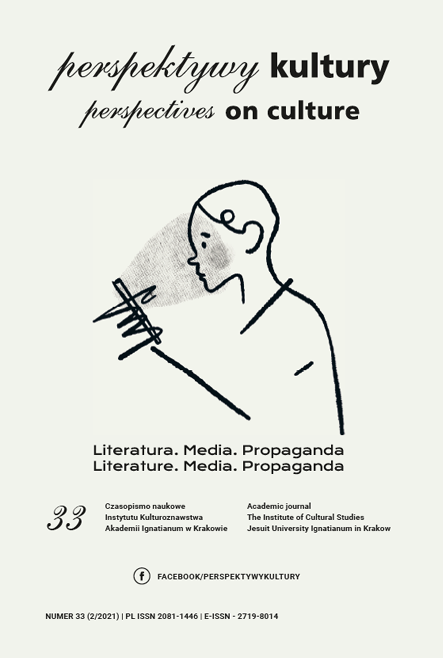Media Representation of the Moment of Death: Dying Person’s Dignity in the Teaching of the Church and Journalistic Practice
A Case Study
Abstract
The author of the article poses the question repeatedly asked in the world of media, culture and science, concerning the limits of journalistic integrity and informational necessity in the media coverage of human death, especially in relation to how the moment of a tragic death and its immediate consequences are presented. He considers the teachings of the Church and John Paul II on the necessity of respecting human dignity in journalism, with particular focus on the dignity of the dying person, in addition to the respect towards the body of the deceased person. The author analyzes selected media messages with content of interest from the years 2017–2020, and referring to the reactions of some representatives of foreign media, he makes an attempt to construct a list of postulates for increasing the degree of sensitivity in the area of the discussed issues. In the preparation of this article, which is essentially a case study in journalistic ethics, the method of content analysis was used primarily in relation to the examined media presentations and the analytical‑synthetic method when it comes to extracting ethical guidelines from the analyzed texts and in constructing the conclusions.
References
II Vatican Council (1963). Decree on the Media of Social Communications. Inter mirifica. Retrieved from: http://www.vatican.va/archive/hist_councils/ii_vatican_council/documents/vat-ii_decree_19631204_inter-mirifica_en.html (access: 05.03.2021).
II Vatican Council (1965). Declaration on Religious Freedom. Dignitatis humanae. Retrieved from: https://www.vatican.va/archive/hist_councils/ii_vatican_council/documents/vat-ii_decl_19651207_dignitatis-humanae_ en.html (access: 05.03.2021).
Adam, D. (2019). Unfassbar, dass die BILD das Video dieses psychisch kranken Menschen zeigt. Retrieved from: https://twitter.com/dirk_adam/status/1106657863253016578 (access: 14.12.2019).
Bremer, J. (2012). Szacunek wobec ludzkich zwłok. Spojrzenie filozoficzno-prawne. In B. Grochmal‑Bach (ed.), Pedagogiczna refleksja nad życiem i śmiercią. Kraków: WAM.
Carr, N. (2010). Płytki umysł. Jak Internet wpływa na nasz mózg? Gliwice: Helion.
Czabański, K. (2020). „Rzetelna informacja równie ważna, jak tlen dla człowieka”. Krzysztof Czabański o serwisach dla Białorusi. Retrieved from: https://polskieradio24.pl/5/1222/Artykul/2569421,Rzetelna-informacja-rownie-wazna-jak-tlen-dla-czlowieka-Krzysztof-Czabanski-o-serwisach-dla-Bialorusi (access: 01.09.2020).
Depo, W. (2019). Fenomen mediów. Częstochowa: Sekretariat Metropolity Archidiecezja Częstochowska.
Drożdż, M. (2018). Trzeba wracać do podstaw. Niedziela, 5.
Drożdż, M. (2011). Zasady obecności Kościoła w mediach. In M. Przybysz & K. Marcyński (eds.), Media i Kościół. Polityka informacyjna Kościoła. Warszawa: Elipsa.
Goban‑Klas, T. (2005). Cywilizacja medialna. Kraków: WSiP.
Halász, G. (2019). Warum es journalistisch und moralisch falsch ist, komplett auf das Mord‑Video von Christchurch zu verzichten? Retrieved from: https://t. co/ImsAriiW0H (access: 13.12.2019).
Hodalska, M. (2010). Śmierć Papieża, narodziny mitu. Kraków: Wydawnictwo UJ.
Jan Paweł II (1999). Godność człowieka umierającego. Przemówienie do uczestników zgromadzenia ogólnego Papieskiej Akademii Pro Vita. Rzym. Retrieved from: https://opoka.org.pl/biblioteka/W/WP/jan_pawel_ii/przemowienia/cz_umierajacy_27021999.html (access: 12.12.2019).
Jarkiewicz, K. (2015). Medialne oblicze Kościoła. Dyskurs wokół polskiego dziennikarstwa katolickiego. In R. Jasnos & E. Miśkowiec (eds.), Ponowoczesne przestrzenie oddziaływań wychowawczo‑formacyjnych Kościoła i „ziemie niczyje”. Kraków: WAM.
Katechizm Kościoła Katolickiego (1992). Poznań
L’Osservatore Romano (2005). (Polish edition, 4).
Lewek, A. (2008). „Dziennikarz znakomity” według Jana Pawła II. Łódzkie Studia Teologiczne, iss. 17.
Lewek, A. (2010). Informacja w nauce Kościoła o mediach. Kultura – Media – Teologia, iss. 2 (2).
Pastoral Council for the Means of Social Communication (1971). Pastoral Instruction Communio et Progressio on the Means of Social Communication. Retrieved from: http://www.vatican.va/roman_curia/ pontifical_councils/pccs/documents/rc_pc_pccs_doc_23051971_communio_en.html (access: 03.05.2021).
Pindur, M. (2019). Zurückhaltung beim Umgang mit Propagandavideos geboten. Retrieved from: https://www.deutschlandfunk.de/video-des-is-chefs-zurueckhaltung-beim-umgang-mit.2907.de.html?dram:article_ id=447562 (access: 11.02.2020).
Pius XII (1957). Miranda prorsus. Rome. Retrieved from: https://www.papalencyclicals.net/pius12/p12miran.htm (access: 04.05.2021).
Pius XII (1953). Address to the Representatives of the Diplomatic Corps Accredited to the Holy See.
Podlewski, T. (2020). Informacyjne i formacyjne funkcje diecezjalnego portalu internetowego na przykładzie archidiecezji częstochowskiej. Studium przypadku. Unpublished master’s thesis.
Przybysz, M. (2011). Obieg informacji w Kościele. In M. Przybysz & K. Marcyński (eds.), Media i Kościół. Polityka informacyjna Kościoła. Warszawa: Elipsa.
Strączek, M. (2017). Historia jednej fotografii. Retrieved from: http://historiajednejfotografii.blogspot.com/2017/10/granice-publikacji-super-express-i. html (access: 12.12.2019).
Sziling, L. (2014). Nie można się zwolnić ze śmierci – umieranie jest drogą. Retrieved from: http://sluzebniczki.pl/news,nie_mozna_sie_zwolnic_ze_ smierci__umieranie_jest_droga,396.html (access: 13.05.2020).
Tusch, R. (2019). Kritik an Bild‑Chef Julian Reichelt wegen Veröffentlichung von Szenen aus Live‑Video des Attentäters. Retrieved from https://meedia.de/2019/03/16/unfassbar-kritik-an-bild-chef-julian-reichelt-wegen-veroeffentlichung-von-szenen-us-live-video-des-attentaeters (access: 14.12.2019).
Żurawski, J. (2015). Relacjonowanie wydarzeń tragicznych przez dziennikarzy. Aspekty prawne i etyczne. In E. Krajewska‑Kułak, C. Łulaszuk, J. Lewko & W. Kułak (eds.), W drodze do brzegu życia, vol. XIII. Białystok: Wydawnictwo Uniwersytetu Medycznego w Białymstoku.
Copyright (c) 2021 Jesuit University Ignatianum in Krakow

This work is licensed under a Creative Commons Attribution-NoDerivatives 4.0 International License.
Autor, zgłaszając swój artykuł, wyraża zgodę na korzystanie przez Wydawnictwo Uniwersystet Ignatianum z utworu na następujących polach eksploatacji:
- utrwalania utworu w formie papierowej, a także na nośniku cyfrowym lub magnetycznym;
- zwielokrotnienia utworu dowolną techniką, bez ograniczenia ilości wydań i liczby egzemplarzy;
- rozpowszechniania utworu i jego zwielokrotnionych egzemplarzy na jakimkolwiek nośniku, w tym wprowadzenia do obrotu, sprzedaży, użyczenia, najmu;
- wprowadzenia utworu do pamięci komputera;
- rozpowszechniania utworu w sieciach informatycznych, w tym w sieci Internet;
- publicznego wykonania, wystawienia, wyświetlenia, odtworzenia oraz nadawania i reemitowania, a także publicznego udostępniania utworu w taki sposób, aby każdy mógł mieć do niego dostęp w miejscu i czasie przez siebie wybranym.
Wydawca zobowiązuje się szanować osobiste prawa autorskie do utworu.





